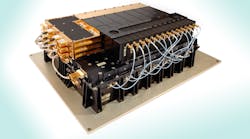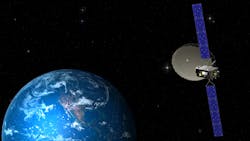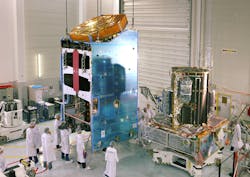The successful launch of Alphasat has put into orbit a communication satellite that can handle more than 10 trillion calculations/second thanks to the digital signal processors (DSPs) used in its design.
Weighing in with a launch mass of 6650 kg, Alphasat is designed for 15 years of in-orbit service. Once its solar arrays are deployed, its wingspan will be 40 meters. It also carries an 11-meter antenna reflector (Fig. 1).
Alphasat was designed and built by Astrium, the aerospace subsidiary of the European Aeronautic Defence and Space Company (EADS) and U.K. satellite operator Inmarsat.It carries a new generation of advanced L-band mobile communications, enabling it to generate in excess of 200 spot beams, with digital beam forming capability, which facilitates the greater use of the spectrum-limited L-band.
The launch and early orbit operations were coordinated from the Astrium spacecraft control center in Toulouse, France. Following liftoff, the satellite had to reach a geosynchronous orbit 22,000 miles above the equator using four engine burns that ate up approximately 3.4 tons of fuel.
Alphasat is also significant because it is the first satellite to use Alphabus, which Astrium says is the most powerful platform currently available. A bus in space parlance is the satellite chassis, propulsion, and navigation equipment. It ensures that the satellite remains in its correct orbit position.
The Alphabus platform can handle satellites with a launch mass of up to 8800 kg, a payload power of up to 22 kW, and a payload mass up to 2000 kg (Fig. 2).
The satellite carries an advanced geomobile communications payload in the L-band that will augment Inmarsat’s broadband network service across Europe, Africa, and the Middle East, providing new capabilities in terms of performance and resource availability. It also delivers additional L-band space segment redundancy and consolidates safety-of-life services for the aeronautical and maritime sectors.
The DSPs employed in Alphasat primarily route and combine channels to the desired beam, along with forming that beam. Digital processing is performed by 17 ASICs within each DSP. In total, the eight processors weigh around 250 kg and can perform more than 10 trillion calculations/second (Fig. 3).
Alphasat also carries four technological demonstration payloads for the European Space Agency (ESA), including a laser communications terminal, developed under German space agency DLR contract. The terminal is a precursor of the operational system for the European Data Relay System (EDRS), enabling very high-speed transmission between low earth orbit (LEO) and geostationary earth orbit (GEO).
Laser terminals are used to communicate information like conventional radio payloads do, but can do so far more precisely and at a much higher rate. The platform is the first of its kind to link LEO satellites to geostationary orbits and has a range of 28,000 miles. LEO channels are becoming increasingly congested, so utilizing GEO for inter-satellite links is necessary to accommodate increasing demand for data transmission.
Also on board is an optical communications payload, TDP 1. The TDP 1 project is carried out on behalf of the Space Administration of the German Aerospace Center with funds from the German Federal Ministry of Economics and Technology (BMWi).
It is a “beaconless” instrument, which means it is lighter and smaller and consumes less power than radio beams. The precision of the laser transmission also means there is far less disturbance because the link between the LEO satellites and payload in GEO is a much narrower connection. It has already been successfully demonstrated for LEO-to-LEO links
Overall, the Alphasat deployment represents an investment of almost €900 million when all the public and private money that has been invested in the project throughout Europe is counted.



